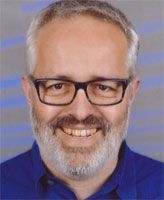About This Webinar
 Join us for a free webinar presented by PCO!
Join us for a free webinar presented by PCO!
Due to advancements in CMOS image sensor technology a new camera system, pco.flim, has been created to allow for easy and fast fluorescence (and phosphorescence) lifetime imaging. The webinar will shortly reintroduce the principle of photoluminescence lifetime imaging. Based on the principle of frequency-domain luminescence lifetime imaging, the features of the new pco.flim camera will be discussed. Further, the simple experimental setup with a microscope in conjunction with an appropriate excitation light source will be shown. Based on experimental results with Förster resonance energy transfer (FRET) and endogenous fluorescence applications, the advantages and limitations of the new FLIM system will be presented.
Presenter Gerhard Holst is head of the research department at PCO AG. He earned a diploma in 1991 from the Technical University RWTH Aachen and a doctorate in 1994 from the University of Dortmund. From 1991 to 1994 he worked at the Max Planck Institute for Systemphysiology in Dortmund, and from 1994 to 2001 he worked at the Microsensor Research Group of the Max Planck Institute for Marine Microbiology in Bremen. He joined PCO in 2001.
Audience questions and the presenter's responses are provided below.
1. Do FLIM images always have the granular appearance?
The "granular" appearance depends on the noise of the signal. If the signal-to-noise ratio is small, if the signal is small the images are noisy and therefore the determined lifetime distribution will be noisy as well. Second, in case of weak signals, it is likely that the exposure times will be longer. If the exposure time is above 1 s thermal noise will appear in the image as well. Therefore, if you look at FLIM images with very weak signals, they tend to be noisier => more granular. But in principle, FLIM images are not necessarily granular.
2. Does increasing the number of frequencies increase the accuracy of lifetime estimation?
An increasing number of phase angle samples might help to increase the accuracy of the lifetime estimation. An increasing number of frequencies helps to determine more than one lifetime. If the the whole decay curve is measured in the time domain, this would correspond in the frequency domain to the measurement of the transmission behavior for all frequencies. If you look to the area scan time domain methods with 2 integration windows, it is only possible to evaluate one lifetime, which is comparable to the measurement at one frequency in the frequency domain.
3. Could you clarify or reiterate why the number of output images equals the number of sampling points?
This is how half period integration is set up; windows correspond to phase angle steps. Each sample point corresponds to the light that is integrated. In case you select more phase angle steps, you would measure more images that are used to fit a sinusoidal signal and get the required information about amplitude, constant part and phase angle.
4. In FRET, is the true/quenched fluoresence lifetime the phase lifetime?
So far, phase angle-derived lifetime is used because modulation based lifetime wasn't corrected for intensity dependence at the time. Corresponds directly to FRET efficiency. In FRET the lifetime of the donor molecule corresponds to the FRET efficiency, which is a measure of the distance of the FRET molecules, as far as I know. We have used the lifetime based on the phase angle determination because it gave a more reliable measurement. For the modulation index lifetime measurement, which should give the same results, we are working on a correction of the intensity dependence of the modulation index signal.
5. What are the lifetime ranges that can be detected using this camera? Are NIR lifetimes (~1ns and below) feasible?
If the signal to noise ratio is good enough (needs to be tested). It should be possible; precision may not be able to separate 10th of picoseconds; 100 ps.
6. Can you talk about the consistency of the signal and noise across the sensor. Are all pixels the same? Does the readout method affect how the different pixels are measured and the resulting information?
For high modulation frequencies (appr. > 5 MHz) there is a distinct North-South-behavior of the image sensor, but this as well is cancelled out with the reference measurement. Further, each camera is measured and calibrated, such that each pixel delivers for both taps a linear signal. Therefore all pixels behave the same. Re: the question about the effect of the readout method: can you send me an e-mail to further explain and discuss it.
7. How difficult would it be to couple the pco.flim setup to a spectral LED light source to perform combined spectral/flim measurements?
If the spectral LED light source can be controlled with the modulation signal (+/- 0.5V @ 50 Ohm) and the dark gate signal (LV-TTL > 200 Ohm) of the pco.flim camera, and you have references for the lifetime measurements in the corresponding spectral range, why not?
8. Also, can you provide a comparison between the theoretically achievable separation of different lifetimes in the freq. domain vs that achievable using the pco.flim system (assume a tau 1-10ns). i.e. what's the tau resolution?
That's a tough one, in the suggested range we did measurements that showed that we are able to resolve 100 ps if the SNR is good enough. Maybe we can go better, but with the existing experiences I would answer we will have to further test. We would need to design a proper experiment with known lifetimes, which allow for the measurement if the single lifetimes are spatially separated. In case you have an overlap, at one frequency you are only able to measure an apparent lifetime. Theoretically the precision in the frequency domain is as good as in the time domain, if you compare correctly.